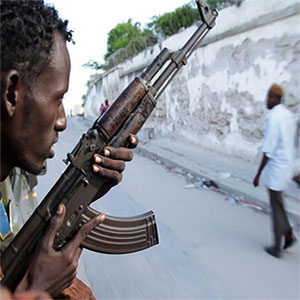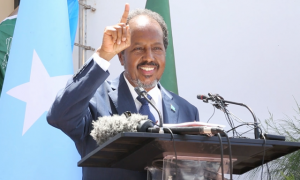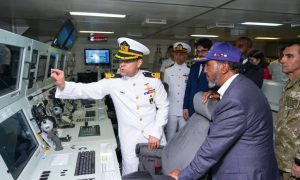
Mogadishu-September 21, 2015- Africa’s biggest peacekeeping mission, the African Union Mission in Somalia (AMISOM), has suffered huge losses these past few months.
This has sparked a rethink of the strategy and composition of AMISOM.
Some experts argue that the ambiguity around casualties undermines the mission.
Every United Nations peacekeeping mission has its own website. And there, in bold type in the ‘Fact and Figures’ section, is a statistic: the number of peacekeepers who have lost their lives serving in that particular mission.
This transparency is in stark contrast to that of the African Union’s (AU) highest-profile peacekeeping mission, the AU Mission in Somalia (AMISOM). AMISOM has been in Somalia for eight years now, but accurate information on injuries and fatalities is notoriously difficult to come by.
A case in point: On 1 September 2015, al-Shabaab attacked an AMISOM base in the small town of Janaale, Lower Shabelle region. Al-Shabaab’s propaganda unit declared the attack to be a major victory, and claimed that it had killed more than 50 AMISOM soldiers. While acknowledging the attack, AMISOM refused to comment on the number of casualties it had incurred.
AMISOM refused to comment on the number of casualties it had incurred TWEET THIS
To this day, we still do not know the exact number of soldiers who died in Janaale. What information we do have comes from the Ugandan People’s Defence Force, as it was AMISOM’s Ugandan contingent that was operating in Janaale – but even the Ugandans cannot agree on an exact number.
Rosebell Kagumire, a Ugandan journalist, explained the difficulties she faced in trying to extract an accurate death toll from the authorities: ‘Our army spokesperson first said 10 people but we knew it was a big attack, and it took them 40-something hours to come up with that number.
This makes it suspicious – it wouldn’t take so long when just 10 people were killed. It was like they were taking time to come up with a figure that would not arouse anger in the country about the lack of protection for soldiers, and to prevent people from questioning the tactics of peacekeeping forces.’
This number then changed: another military spokesperson said 12, and on a state visit to Japan Uganda’s President Yoweri Museveni said it was 19. ‘Sometimes we get more accurate numbers from al-Shabaab,’ said Kagumire.
A matter of policy
As a matter of policy, AMISOM is not allowed to release specific casualty counts. Officially, the mission delegates this responsibility to troop-contributing countries, each of which has its own policies about how to handle the information. Uganda, for example, will not release numbers until the families of the victims have been informed. Ethiopia, on the other hand, has a policy of not commenting on casualty counts at all, treating this information as a state secret.
It is also not always easy to gather this information in the first place. ‘AMISOM is beset with technical challenges that prevent good and timely reporting of anything, including casualties. Poor communications, within each military’s sector and between each force, is a big issue here. Commanders right down to the basic platoon leader have difficulty coordinating communications equipment and protocols, meaning you often end up with a broken telephone process of reporting any aspect of operations, including casualties,’ said John Stupart, editor of the African Defence Review.
Sometimes we get more accurate numbers from al-Shabaab
TWEET THIS
From AMISOM’s perspective, this ambiguity around casualties is a double-edged sword. ‘On the plus side for the military involved, it allows their ability to control the message, as it were, about engagements with al-Shabaab. Obviously this only works in skirmishes or outcomes where AMISOM forces are victorious, and not like the case where 50 Burundians are killed and a base overrun [in the town of Leego in June this year].
On the downside, it rapidly erodes public trust to hide or simply be unable to accurately report your war dead. If the dead are not reported and, most importantly, honoured, you can very quickly lose domestic support for your expedition in Somalia,’ said Stupart.
Kagumire argues that, in Uganda, the domestic support is already wavering. ‘First of all we need to honour [fallen soldiers], the families need to know the sacrifice to serve in another country is appreciated. It’s important they feel some level of appreciation. When they see numbers saying 10 died and then only 10 names are published, but you know your relative is dead and his name doesn’t come out, it’s a form of disenfranchisement for these families. The false information has a ripple effect on how families and communities feel … It’s a question of transparency, but also of honour.’
‘Impossible to provide an accurate figure’
In a special report, Paul Williams, Associate Professor of International Affairs at the George Washington University and co-author of Counterinsurgency in Somalia: lessons learned from the African Union Mission in Somalia, 2007–2013, attempted to pin down exactly how many fatalities AMISOM has suffered in total. Estimates vary from a little over 1 000 deaths to more than 4 000 deaths, but Williams concludes that ‘it remains impossible to provide an accurate figure for the number of peacekeepers who have sacrificed their lives serving on this mission’.
This ambiguity around casualties is a double-edged sword TWEET THIS
Williams outlines three reasons why this is important. First, peacekeepers who die deserve to have their sacrifice publicly recognised. Second, families of the victims are eligible for compensation payments, which cannot be made if their deaths are not acknowledged. ‘Reports persist that compensation payments to next of kin are sometimes delayed for long periods and might not always be for the amount stated in the Memoranda of Understanding,’ noted Williams.
Third, the ambiguity over casualties could have a negative impact on AMISOM’s ability to fulfill its mandate. ‘[T]he deliberate policy of keeping such information secret has arguably contributed to undermining AMISOM’s credibility to the extent that its strategic communications are perceived by many Somalis to be unreliable. No modern peace operation can succeed if it does not have the support of the local population, and greater clarity about the issue could be an important part of re-establishing AMISOM’s credibility as a trusted source of information and demonstrate the sacrifice AMISOM’s contributing countries have endured in the effort to bring peace to Somalia,’ said Williams.
Although AMISOM has made considerable progress in Somalia over the years, the fight against al-Shabaab is far from won – and it is likely that many more peacekeepers will die before the mission has fulfilled its mandate. Perhaps now is the time for the mission, and the AU’s Peace and Security Council, to examine whether its policy around the release of casualty figures is helping or hindering its efforts.
.
Source:The Institute for Security Studies
_________________________
_____________________________________________________________________________________
Xafiiska Wararka Qaranimo Online | Mogadishu, Somalia
_____________________________________________________________________________________Advertisement
_____________________________________________________________________________________








